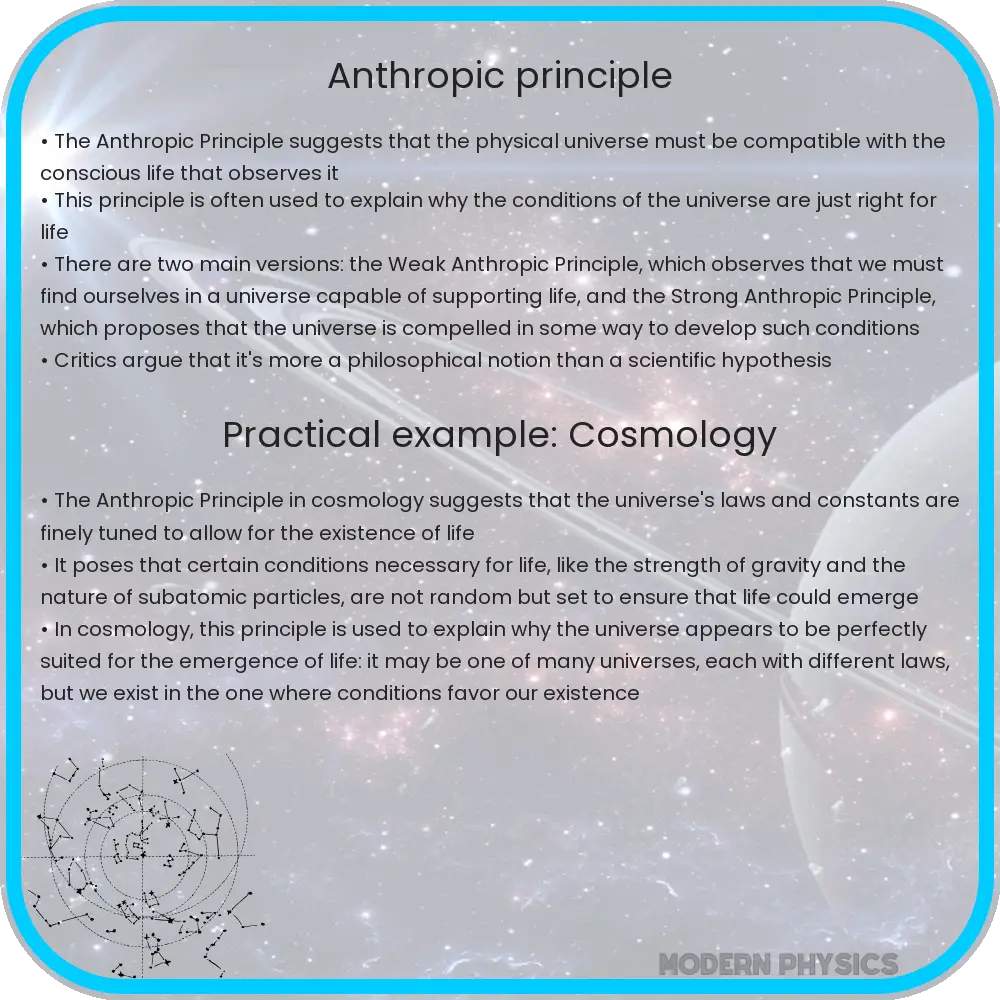Explore the Anthropic Principle in cosmology, examining how the universe’s laws may be finely tuned for life and the debates surrounding the multiverse theory.

Understanding the Anthropic Principle in Cosmology
The Anthropic Principle is a philosophical consideration that has intrigued scientists and philosophers alike, particularly in the realms of cosmology, physics, and astronomy. This principle suggests that the universe’s fundamental physical constants and laws appear finely tuned to support life, leading to significant implications for understanding our place in the cosmos. There are two main variants of the Anthropic Principle: the Weak Anthropic Principle (WAP) and the Strong Anthropic Principle (SAP).
The Weak Anthropic Principle (WAP)
The WAP posits that the observable universe’s conditions must allow the observer to exist – it is more a statement about observational bias than a physical law. This principle does not assume that the universe was designed with life in mind but simply states that we, as observers, find ourselves in a part of the universe that can support life. The existence of life in the universe is therefore not a result of pure chance but rather a consequence of the universe’s laws and constants being within a narrow range that enables life to develop.
The Strong Anthropic Principle (SAP)
Contrasting with the WAP, the SAP takes a more controversial stance by suggesting that the universe must have properties that eventually permit life to emerge within it at some stage. This principle implies a teleological aspect: that the universe is in some way destined to create observers like humans. Critics argue that this principle borders on the theological, as it suggests a purpose behind the universe’s very existence.
Cosmological Implications
The Anthropic Principle has profound implications for cosmological theories, especially in the context of the multiverse theory and fine-tuning. The fine-tuning argument, often associated with the Anthropic Principle, points to the precise nature of the physical constants: if they were even slightly different, the universe as we know it would not exist, and life would be impossible. This delicate balance raises questions about the likelihood of our universe being one of many in a vast multiverse, where each universe has different constants and laws of physics.
Exploring the Multiverse Theory and Fine-Tuning
The idea of a multiverse has been proposed as a scientific hypothesis to address the fine-tuning observed in the physical constants. According to this theory, our universe is just one of countless others, each with its own set of physical laws and constants. In such a scenario, it is not surprising that we find ourselves in a universe that supports life; if there are infinite universes, it stands to reason that some would possess the necessary conditions for life. This perspective provides a natural explanation for the anthropic fine-tuning without resorting to design or purpose inherent in the universe.
Challenges and Criticisms
Despite its intriguing premises, the Anthropic Principle and the associated fine-tuning argument are not without criticism. Skeptics argue that these ideas inject a sense of purpose or design that may not be present in the universe. Others point out that our understanding of life and its requirements is still evolving, and what we consider as “fine-tuned” conditions might not be as rare or unique as currently believed. Additionally, the lack of empirical evidence for the existence of other universes makes the multiverse theory speculative at best.
Philosophical and Scientific Implications
The Anthropic Principle bridges the gap between philosophy and science, prompting discussions about the nature of the universe and our place within it. It challenges scientists and philosophers to ponder the fundamental questions of existence, such as why the universe has the properties it does and what it means for life to exist. While it may not provide definitive answers, the Anthropic Principle stimulates important debates in the scientific community and beyond, highlighting the intricate relationship between the cosmos and the emergence of life.
Conclusion
The Anthropic Principle remains a fascinating concept that underscores the complex interplay between life and the cosmos. Whether viewed through the lens of the Weak or Strong Anthropic Principle, it raises profound questions about the nature of the universe and our existence within it. While the fine-tuning of the universe may suggest a remarkable coincidence or point towards a vast multiverse, it ultimately enhances our appreciation for the profound mystery of existence. As our understanding of the cosmos deepens, the Anthropic Principle will continue to inspire and challenge our perceptions, reminding us of the delicate balance that allows life to flourish in the vastness of space.
